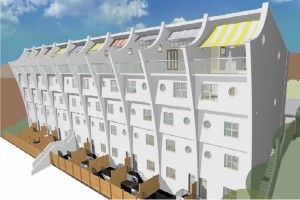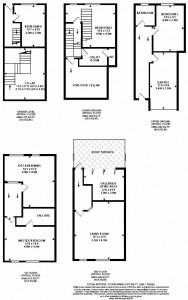

Some may say that all this carbon offset thing is silly, but as far as the business is concerned, it is much better to build a concrete house and do something for the environment than to build a concrete house and do nothing.
Shoreline Townhouses is a new residential project in Hastings by Phoenix Trinity. Although they are not revolutionary in the method of building or material choice (apart from some hi-tech eco-features), they are special in the way they will neutralize and even reduce the grey energy that has gone into building them. Phoenix Trinity has chosen bio-charcoal pyrolysis as their method of carbon offsetting. They are using Biochar technology to achieve this.
One must remember, though, that by doing the pyrolysis the wrong way, methane will be emitted, which is the worst of the greenhouse gases. Besides, heat is necessary to carry out pyrolysis, that’s why making Biochar is a process that has a long-term benefit and you cannot expect it to change the world overnight.
The best thing about this method is that it removes the fallen trees and biomass from the woodland and converts it into a valuable source of natural fertiliser. Otherwise it would stay there and rot away releasing greenhouse gases for many years.
Shoreline Townhouses are situated on a pleasant residential street that runs parallel to the St Leonards Promenade. The Hastings beach is just a 3-minute walk from the townhouses. Prices start at £375,000.
Phoenix Trinity has partnered with a local company to completely offset the CO2 impact of construction of their eco-homes in a revolutionary new system that takes the CO2 out of the atmosphere in a 2-3 year cycle. They guarantee to offset the first three years of estimated domestic emissions for every eco-home they build.
Although the majority of materials used in this build cannot be classified as eco-friendly, the townhouses will have quite an impressive eco-feature list:
- Ambient light and heat-harvesting via glazing, Solar Panel and Air Transfer Systems.
- A clever use of cellar space. The house reduces the footprint by going “UP” (more about this issue in the article about eco house size).
- Bio-Mass log burners to heat the main living room.
- Altherma Energy Air source heat pump.
- Insulation and heat retention that significantly exceeds new UK standards.
- LED and low energy lighting features.
- European manufactured supplies and Scandinavian FSC timber to reduce transport impacts (The last one’s very important. Not only it reduces the transport impact, it also promotes ethical business).
Here’s what Simon Hinton, Managing Director of Phoenix Trinity, has to say about their carbon offset method:
“It is about taking responsibility and trying to undo the mess, and arose from the fact that the construction industry has the largest commercial transportation CO2 footprint in the UK. I wanted to make a medium costing development energy-efficient, eco-friendly and MORE than neutralise the embedded carbon.
I wanted to offset effectively and thought Biochar could be one of our biggest saviours in the war against Climate change. Developed by Amazonian women, it squares the circle by sequestering the carbon for 1000s of years, and creates high nutritious organic fertiliser into the bargain. This of interest because a lot the world’s CO2 increase was created by intensive farming and deforestation from around 1750-the present date. When biomass is heated at a high temperature without oxygen charcoal is created and no greenhouse gases emitted.
The person I work with is Craig Sams who started Green and Blacks Chocolate and helped thousands of south American farmers grow rich by weaning them off oil based fertilisers and on to organic farming methods; in time their crops were greater and they were no longer in debt to the nitrate producers. With such a great record I sat up and took notice and was inspired by this man’s work, expertise and dedication to find sustainable solutions.”
There are other carbon offset methods: Generation of green electricity, Destruction of industrial pollutants, Planting trees, Methane collection and many others. Have you just finished building a concrete house? And what have you done to offset your impact?